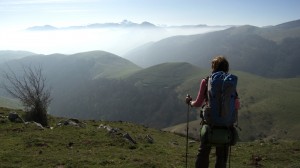Reviews: Now Playing

Tusk (Kevin Smith, USA, 2014, 102 min)
Now Playing at Multiple Venues (link to Flixter)»
I’ll begin at the end credits, which in turn takes us back to the beginning of the production of Tusk. As the credits roll, we hear an excerpt from Episode 259 of SModcast, “The Walrus and the Carpenter,” in which Kevin Smith and Scott Mosier construct a story based on a Gumtree ad offering free room and board for someone willing to dress as a walrus. The story was transformed into a comedic horror scenario, where a lodger is surgically transformed into a walrus. The podcast excerpt has the giddy, playful energy that brought me back to high school lunchroom conversations with my friend Jay Antani (now a critic at Cinemawriter.com) as we would conjure up absurd scenarios that could never be made. Unfortunately, only the last third of Tusk delivers on that kind of absurd energy, and it never quite matches the fun of the original conversation (despite the fact that fans appear to be pleased with the film’s faithfulness). The first two-thirds of the film consists of typically labored Kevin Smith comic dialogue, redeemed only by the performances by Michael Parks and “Guy LaPointe” (okay, I know you know who it is already, but I’ll play along with the film’s credits, since I did not know going into the film). It’s not even worth summarizing the plot beyond “man transformed into walrus,” because who really cares about the rest of it (did anyone need a longer description than “human centipede”)?
I actually would have liked more humor in the film, just not humor written by Kevin Smith. He is a fun guy to have around and listen to, which is why his podcasts are so successful. I genuinely do like the guy. But he is a lazy writer and filmmaker who depends far too often on performances to bail him out. Justin Long is game enough to try, but he is hampered by an intolerable character, podcaster Wallace Bryton, and dialogue so tedious that his “adorable funny asshole” shtick just comes across as “asshole.” It comes as a relief when the walrus transformation is revealed (in an admittedly funny zoom out), in part because we won’t have to listen to Wallace talk about his “Not-See Party” podcast (get it?) after his tongue is removed. (Please consult Roger Ebert’s First Rule of Funny Names: “Funny names, in general, are a sign of desperation at the screenplay level.) The relief is short-lived, however, because the film has a cumbersome flashback structure, so we’re burdened with even more asshole backstory that diffuses all narrative momentum.
At least Smith has enough good sense to let Michael Parks just do his own thing as psychopath Howard Howe. As in Kill Bill, Parks performs two wildly different personas, so different in fact that one does a double take before realizing that both are indeed Parks. The best scene features Parks and “LaPointe” just going for it, performance wise, and it is great fun to watch. But Howard Hawks once said that a great film has three great scenes, no bad ones. Being generous, Tusk might have two very good scenes, but several bad ones.
Then again, those two good scenes make Tusk one of Kevin Smith’s better recent films (you can probably sense that I am not a fan of his films, so I can’t say for sure). I had the disadvantage of watching this at a press screening, and the film seems to play much better to an audience; it was named first runner up at the Toronto International Film Festival’s Midnight Madness Audience Award. I’ve mentioned the “echo chamber” of the film festival circuit in a negative review of The Rocket, which then went on to win the audience award at the Wisconsin Film Festival. So it is certainly possible that Tusk will play better to a crowd than I’m giving it credit for here. If you find that to be the case when you see it, please share your thoughts in the comments below.

Walking the Camino: Six Ways to Santiago (Lydia B. Smith, USA, 2013, 84 min)
Sundance Cinemas through October 2»
If you missed the opportunity to screen Walking the Camino: Six Ways to Santiago this past weekend, you also missed an opportunity to see the film with the director Lydia B. Smith for Q & A screenings at Sundance. But there are a few more days to see the film in the Sundance Screening Room. It is not a particularly strong documentary film, but it does provide a glimpse into the experience of the pilgrimage to Santiago, Spain for both people of faith and those looking for other answers to life’s questions. One comes away from the film understanding in very general terms the value and significance of the pilgrimage both historically and personally for the pilgrims we meet. But as a film viewing experience, one also has to tolerate repetition, generic music, and interviews telling us rather than the camera showing us the drama.
My main issue with Walking the Camino is about structure and storytelling. The film falls into a trap that is common with current feature length documentaries: rather than providing a strong narrative arc or central argument across the duration of the film, the filmmakers simply add more stories or more examples of the topic being explored. In the case of Walking the Camino, not all of the “ways” are equally compelling, and some of the participants are not particularly engaging, given that we meet several pilgrims facing many of the same obstacles. And even for those pilgrims who do have specific conflicts or relationships that must be dealt with in the course of the film, there is very little on-screen drama because those conflicts are discussed in interviews rather than played out in front of the camera.
The film ends with a series of cross-cut voice overs where the participants summarize their experiences. The language they use is for the most part repetitive and generic, even though we know that their individual experiences must have been very personal and unique ones. The film does a good job informing us what the Camino is, and we are told what it means, but we never effectively feel what it means to embark on and complete the journey.